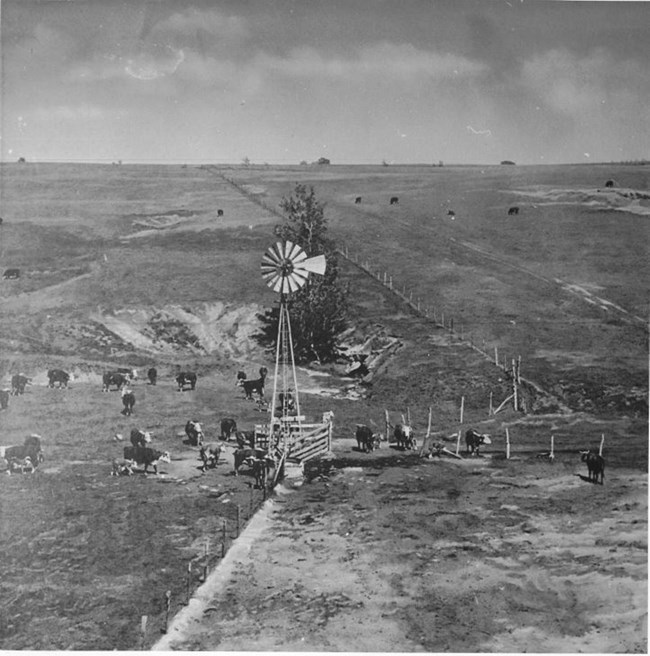Last updated: May 10, 2019
Article
Windmills on the American Plains

NPS Photo
In the 18th century, the Great Plains were considered unfit for cultivation. The area was termed the “Great American Desert.” Droughts would follow rainy spells and the sun and wind would dry up surface moisture.
On the Plains, early settlers could barely haul enough water for personal needs, let alone grow crops or water livestock. The majority of the water flowed deep underground, often more than 300 feet below the earth’s surface.
European windmills were impractical on the American Plains. They were large, expensive, and required constant maintenance as their cloth sails had to be furled by hand.
American-Style Windmills
In 1854, Daniel Halladay developed the American-type windmill. It was smaller, less expensive and could be shipped and built easily. Its sails were held into the wind by a weight, which would rise slowing to reduce the area of the sails when the wind was too fast. Traditional cloth covered sails were soon replaced with smaller wooden blades.
These new windmills were ideal for settlers on the plains. They could pump water from great depths at a steady rate. They could shift into the prevailing winds and functioned well in fast and slow winds. And to top it off, they required little maintenance compared to European windmills.
Self-governing water pump windmills soon became a staple on the plains. Homesteaders, farmers, and ranchers were no longer dependent on natural water as they could drill wells and pump water. Windmills were often among a homesteader’s most prized possessions. The water pumped by windmills was used to cook, bathe, drink, water crops and animals, wash clothes, and more. These mills were simple, well-constructed, and dependable.
Railroads were another important customer. Steam locomotives had to be watered at regular intervals. On the first transcontinental railroad, windmills were placed about every twenty miles to pump water for the trains.
Knowing windmills could be counted on for water helped speed up western migration. Ranchers could build up herds, farmers planted more, and railroads could pump water into tanks along their routes. The availability of water allowed the Great Plains to become the nation’s breadbasket.
Windmill Innovations
By the 1870’s and 1880’s, there were hundreds of companies manufacturing windmills. Most of these companies were located on the eastern edge of the Great Plains or in the Midwest.
Wooden solid-wheel windmills were widely produced in the mid- to late-19th century. They have a rigid wooden wheel that adjusts the angle of the entire windmill head to control its speed. In slow winds, the wheel points into the wind for maximum efficiency. In high winds, the wheel moves toward the vane to minimize surface area and prevent damage.
By the 1880s, vaneless windmills were growing in popularity across the central Great Plains. These windmills had hinged sections that could pivot in and out of the wind individually. This allowed them to regulate the speed of the mills as wind speeds changed. Because they had no vanes or tails to direct them into the wind, their wheel operated downwind.
The first successful all-metal windmill was marketed in 1876, but metal windmills were not common until the 1890s. Metal windmills had curved blades allowing them to capture more wind than flat wooden blades. Steel mill designs often used open back-gears instead of a direct-stroke mechanism. These innovations allowed the metal mills to out-pump many wooden mills.
Direct-stroke mills pumped water every wheel revolution. Back-geared mills needed around three revolutions per pumping cycle, but run better in lighter winds. The wheel on a back-geared spins quickly, while a direct-stroke mill must turn slowly to build up the force to pump water.
Self-oiling mills became popular in the 1920’s. These windmills had an enclosed gearbox with an oil-bath that would lubricate the moving parts of the mill as the moved. This meant maintenance on these mills was minimal. They only required cleaning and new oil about once a year. As companies began creating self-oiling mills, they often discontinued the older steel models.
Over time, windmills became visual icons in the Great Plains. On the flat plains, tall windmills were often the most obvious signs of civilization. Many people growing up on the plains have fond memories of windmills from cool drinks after working in the field to learning how to swim in livestock tanks.
Decline of Windmill Manufacturing
The business of windmills faltered following World War I. Electricity and gasoline became cheaper while agricultural commodity prices deceased. People could not buy new windmills and they had cheaper alternatives. The situation worsened for windmill manufacturers with general economic depression during the 1930s.
The 1935 Rural Electrification Act enabled more farms to have electricity. They could now use electricity to operate electricity-power pumps. Decreasing demand for windmills almost eliminated the windmill market.
By the 1960’s, most windmills were sold to developing nations around the world or to three specific cattle ranching regions of the Plains. These areas were the sandhills of western Nebraska, the panhandle of Oklahoma and Texas, and southwestern Texas. In these remote areas, stringing electric lines for stock tanks was inefficient.
When energy prices spiked in the 1970s, people became interested in windmills again. There were only three remaining windmill manufacturers at that time: Aermotor, Baker, and Dempster. Each of these companies went from producing a couple hundred windmills per year to several thousand.
In the 1980’s, significant research went into wind power becoming a commercial source of electricity. Wind turbines became the new face of wind energy leaving water-pumping windmills to a niche market.
Today, water pumping windmills continue to be used on rural ranches and small-scale farms.
If you are interested in learning about one company who produced windmills, check out A History of Dempster Windmills.
